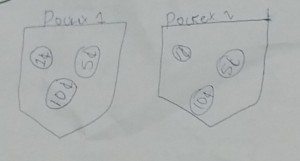I’d compare the struggle between teachers and learners at the end of the year to that of a parent trying to carry a limp child to their bed. Eventually they will both get there, but the parent is frustrated and the child is attempting to make things as difficult as possible. In the end, neither party is probably happy.
Rather than focus on that inevitable struggle, I want to detail a fun experience (for me) that I had with my daughter this past weekend. Her four-year-old rebellion has included a resistance to completing her math and language at school and a refusal to engage in those conversations at home. Grandma and Grandpa were in town this weekend, which gave me an opportunity to exploit her desire to impress them.
At school, Maria is given “problems” similar to the ones on this sheet. They seem randomly chosen, and the children are given beads to model the problem if needed. 
Given the opportunity to exploit the situation, I handed her 12 beads and wrote down 4 + 4, 5+3. 3+5, 2+6, 6+2, 1 + 7, and 7+1.
After protesting that 5 + 5 (her favorite after 4 + 4) wasn’t on there, she started sorting the beads into two piles.
I noticed:
- She knew 4 + 4 by memory and did not use the beads. (Same with 5 + 5)
- She sorted 5 + 3 into a pile of 5 beads and a pile of three beads.
- She did not grab the beads to do 3 + 5 but rather recognized it was the same two numbers and therefore totaled 8.
- 6 + 2 required her to count the beads but she did not grab new beads. She simply rearranged the original piles.
- At 2 + 6 she was onto me and simply filled in “8” for the remaining answers.
Maria: Mommy, this math is stupid.
Me: Why do you think it is stupid, my sweet little bucket of sunshine?
Maria: All of these are the same answer.
Me: And what makes that stupid to you?
Maria: It is just stupid. Math is stupid. I never want to do math again.
(Awesome.)
This reaction makes me very curious about where her feelings of “this is stupid” comes from. She’s only 4. She has much less experience with “answer getting” than, say, a teenager. Yet, her evaluation of the task being “stupid” seems to stem from the idea that if the answer is always the same, why do the problem in the first place? Is the mentality of “answer over process” more innate than we think? Or is it simply so pervasive in our education system that even my 4 year old has picked up on it?
Number flexibility is something I’ve made routine in my classroom as of late. Detailing different strategies to arriving at the same result gives students a stronger foundation on which to build algebraic thinking.
Sigh. It might be a long summer, but she’ll learn I don’t give up so easily.
















